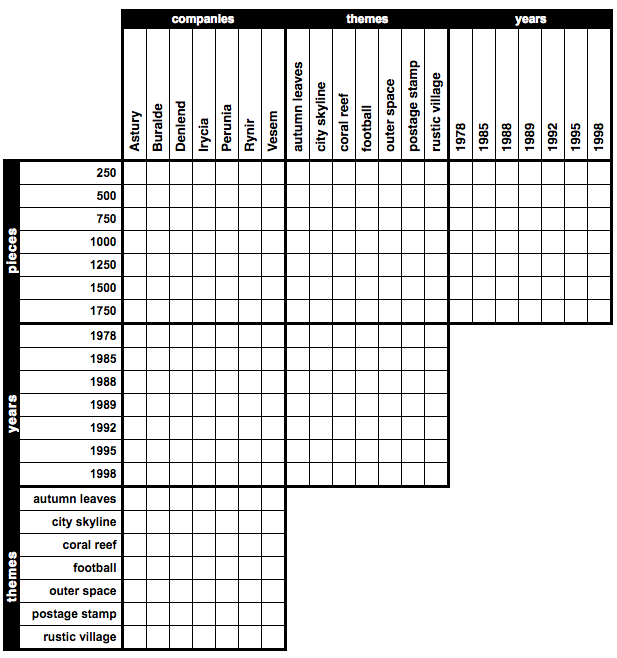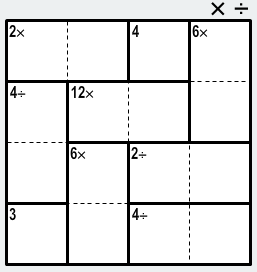User Tools
Sidebar
Table of Contents
Corning Community College
CSCS2330 Discrete Structures
~~TOC~~
Project: WEEKLY PUZZLE FUN (wpfD)
Part 1: 7x7 logic-grid puzzle
Objective
To apply your skills in the solving of a logic puzzle.
Puzzle Backstory
Jack has added several new jigsaw puzzles to his sizable collection this year. Determine each puzzle's size (number of pieces), theme, issuing year and company.
Puzzle
Clues
- The puzzle released in 1998 has somewhat fewer than the puzzle with the football theme.
- The puzzle made by Vesem doesn't have exactly 1750 pieces.
- The jigsaw puzzle with 1000 pieces is either the puzzle made by Denlend or the jigsaw puzzle released in 1992.
- The jigsaw puzzle released in 1989 has the coral reef theme.
- The jigsaw puzzle released in 1995 has 250 more pieces than the jigsaw puzzle released in 1978.
- The puzzle with 500 pieces doesn't have the outer space theme.
- The puzzle with the postage stamp theme has somewhat more than the jigsaw puzzle with the outer space theme.
- The puzzle with the rustic village theme has 250 fewer pieces than the jigsaw puzzle released in 1998.
- The jigsaw puzzle made by Irycia wasn't released in 1989.
- The jigsaw puzzle made by Astury is either the jigsaw puzzle with 250 pieces or the jigsaw puzzle released in 1978.
- The jigsaw puzzle released in 1978 is either the jigsaw puzzle made by Vesem or the jigsaw puzzle with the postage stamp theme.
- The puzzle made by Denlend wasn't released in 1989.
- The jigsaw puzzle with 1000 pieces, the puzzle made by Denlend, the jigsaw puzzle released in 1985, the jigsaw puzzle made by Perunia and the jigsaw puzzle with the postage stamp theme are all different puzzles.
- The jigsaw puzzle released in 1992 has somewhat more than the jigsaw puzzle with the rustic village theme.
- Of the puzzle with 1750 pieces and the puzzle made by Astury, one has the coral reef theme and the other was released in 1988.
- The puzzle with 750 pieces is either the puzzle with the autumn leaves theme or the puzzle with the rustic village theme.
- The puzzle made by Perunia has 250 fewer pieces than the puzzle released in 1985.
- The puzzle with the rustic village theme has 750 fewer pieces than the jigsaw puzzle made by Buralde.
Part 2: Word Math Puzzle
Objective
Logic grids are not the only form of logic puzzle; here is another one that relies heavily on logic and reasoning in order to sift through.
A word math puzzle is one where the numbers 0-9 have been replaced with various letters of the alphabet; it is your task to determine what number each letter maps to, and report that to me in the project submission.
For this sort of problem, you will likely want to take notes; all the various little tests you concoct to prove or disprove some relationship. This may also take a bit longer and seem more overwhelming, but really, it is just longhand math :) Remember to attack the problem in pieces, and not head-on all-at-once.
Practice some similar math problems to derive patterns so that the seemingly unfamiliar letters performing math can start to make more sense.
Puzzle
HE
+-------
SPOT | PLUSHY
-PUHEH
-----
OERUY
-OSYSH
-----
PRSE
| number | 0 | 1 | 2 | 3 | 4 | 5 | 6 | 7 | 8 | 9 |
|---|---|---|---|---|---|---|---|---|---|---|
| letter |
Part 3: Numerical Reasoning
Objective
With the logic grids you put your logic skills to the test, with the word math you math skills. Here, we will explore various other types of puzzles, often combining both logic and math skills to solve, but also exercising different aspects of your deduction/induction skills.
By popular request, here is a kenken– similar to sudoku, but you are constrained by mathematical domains vs. pure unique placement of values.
Puzzle
Submission
To submit this weekly puzzle, simply run the submit line below; a submit-time questionnaire will collect your puzzle results.
Submit Tool Usage
When you have completed work on the project, and are ready to submit, you would do the following:
lab46:~/src/discrete/wpf$ submit discrete wpfD Submitting discrete project "wpfD": SUCCESSFULLY SUBMITTED lab46:~/src/discrete/wpf$



